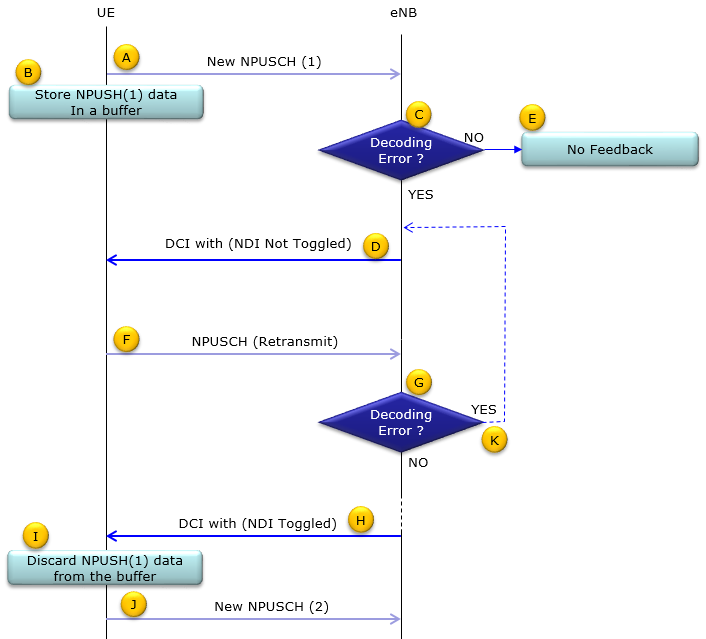|
4G/LTE - LTE NB |
||
|
HARQ
In short, HARQ mechanism for LTE NB(M2) downlink is similar to legacy LTE mechanism (except the repetitive transmission), but HARQ mechanism is a little bit different from legacy LTE as described below.
HARQ Operation for Downlink
HARQ Process for Downlink is similar to legacy LTE except that each transmission would happen in repetition in LTE-M1. The rough HARQ sequence would be as follows. i) UE <-- NW : MPDCCH (DCI for PDCCH) in repetition ii) UE <-- NW : PDSCH in repetition iii) UE --> NW : HARQ ACK/NACK Note : Step i) and ii) happens not in the same subframe. (This is different from legacy LTE)
HARQ Operation for Uplink
HARQ Process for Downlink of LTE-NB(M2) is similar to legacy LTE except that each transmission would happen in repetition. However, HARQ Process for Uplink in M2 is different from legacy LTE. The most critical difference is that eNB does not send any HARQ ACK/NACK for PUSCH (It is understandable because there is no PHICH in LTE M2). Then, you may ask how eNB can handle the case where PUSCH reception fail ? Following process would give you the answer. Basically this mechanism is almost same as in LTE BL/CE(M1).
The rough HARQ sequence would be as follows.
i) UE <-- NW : NPDCCH (DCI for NPUSCH) with UL Grant in repetition ii) UE --> NW : NPUSCH in repetition iii) One of the following cases happens : NOTE : If UE does not receive MPDCCH for NPUSCH retransmission, UE assumes that NPUSCH is properly received by NW. PHICH does not exists to send ACK/NACK for NPUSCH in LTE M1. If you turn this into a little bit detailed illustration, it can be as follows (try to follow through the step (A) through (I) and make your own story just like you explain to others)
Step (0) : It is assumed that eNB transmitted UL Grant(DCI N0) and UE successfully decoded it. Step (A) : UE transmit a NPUSCH Step (B) : UE stores the NPUSCH into a buffer in case that it need to retransmit later Step (C) : eNB detected NPUSCH and tries to decode it. If the decoding is successful (no Error), eNB does not send any feedback(no HARQ feedback) If the decoding is not successful (CRC Error), go to Step (D) Step (D) : eNB sends another UL Grant(DCI N0) with NDI Not Toggled (This implies 'this DCI is for Grant to retransmit NPUSCH') Step (F) : UE retransmit (send again) NPUSCH data stored in the buffer Step (G) : eNB detected NPUSCH and tries to decode it. If the decoding is successful (no Error), eNB does not send any feedback(no HARQ feedback) If the decoding is not successful (CRC Error), go to Step (H) Step (H) : (If there is any other data the eNB need to get from UE) eNB sends another UL Grant(DCI N0) with NDI Toggled (This implies 'this DCI is for Grant to transmit a new NPUSCH') Step (I, J) : (After decoding a DCI with NDI Toggled), UE discard the NPUSCH stored in the buffer and send a new NPUSCH.
|
||
